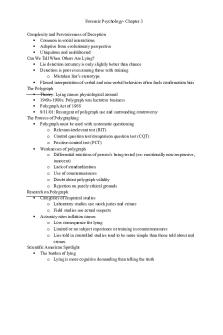Forensic Psychology Chapter 3 PDF

| Title | Forensic Psychology Chapter 3 |
|---|---|
| Course | Forensic Psychology |
| Institution | Southern New Hampshire University |
| Pages | 3 |
| File Size | 79.2 KB |
| File Type | |
| Total Downloads | 32 |
| Total Views | 168 |
Summary
Prof. Papinikalou...
Description
Forensic Psychology- Chapter 3 Complexity and Pervasiveness of Deception Common in social interactions Adaptive from evolutionary perspective Ubiquitous and multifaceted Can We Tell When Others Are Lying? Lie detection accuracy is only slightly better than chance Detection is poor even among those with training o Mistaken liar’s stereotype Flawed interpretation of verbal and non-verbal behaviors often fuels confirmation bias The Polygraph Theory: Lying causes physiological arousal 1960s-1980s: Polygraph was lucrative business Polygraph Act of 1988 9/11/01: Resurgent of polygraph use and surrounding controversy The Process of Polygraphing Polygraph must be used with systematic questioning o Relevant-irrelevant test (RIT) o Control question test/comparison question test (CQT) o Positive-control test (PCT) Weaknesses of polygraph o Differential reactions of person’s being tested (ex: emotionally non-responsive, innocent) o Lack of standardization o Use of countermeasures o Doubt about polygraph validity o Rejection on purely ethical grounds Research on Polygraph Categories of empirical studies o Laboratory studies use mock juries and crimes o Field studies use actual suspects Accuracy rates inflation causes o Low consequence for lying o Limited or no subject experience or training in countermeasures o Lies told in controlled studies tend to be more simple than those told about real crimes Scientific American Spotlight The burden of lying o Lying is more cognitive demanding than telling the truth
Forensic Psychology- Chapter 3 Limited cognitive capacity to manage extra demands of fabricating and managing a lie and suppressing the truth Strategies for lie detection o Requiring reserve storytelling o Insisting on suspect-questioner eye contact o Asking for spatial information through drawing Legal Status of the Polygraph Polygraph results admissible in court in many states 1993 Supreme Court decision (Daubert v. Merrell Dow Pharmaceuticals o Admissibility of scientific evidence determined case-by-base based of evidentiary hearings 1998 Justice Clarence Thomas concerns about polygraphing o Lack of consensus about scientific validity and reliability o Concern that polygraph evidence usurps jury role Alternative Polygraph Method Guilty Knowledge Test limitations o Sufficient number of crime facts must be available o Facts must not be widely publicized o Details must be recalled by guilty person o Applicability to large number of crimes may not occur o Resistance of professional polygraphers may occur Hot Topics Lower-Tech Lie Detection: Words and Wizards o Criteria-based content analysis (CBCA) Truthfulness assessment through systematic analysis of written statements High acceptance in European courts Validity questioned o Reality monitoring (RM) Reliance on written accounts of alleged crimes Correct classification rate around 63% o Lie-detection wizards 42 identified wizards notice more cues Detection rate around 80% Facial Action Coding System Paul Ekman and Wallace Friedman, in the 1970s, set up a classification system for human facial expression The Facial Action Coding System identifies 43 sets of muscles, which often work in tandem to facially express emotion Polygraph as Coercion Polygraphs
Forensic Psychology- Chapter 3 o Used to induce confessions o Presented as opportunity to prove innocence Attempts to avoid viewed as guilt; not avoiding viewed as innocence Results sometimes manipulated by polygrapher to coerce suspect Jurors and the Polygraph Jurors generally find results persuasive Results can change outcome of a trial Experts are more skeptical than general public Limited research is available Effectiveness of results based on o Persuasiveness of polygrapher testimony o Sophistication of jurors o Instructions from judge Lies in the Brain and Eyes The brain o fMRI detects ‘where’ the lying occurs o EEG detects ‘when’ the lying occurs The eyes High Definition Infrared Thermal Imaging Eye Movement Memory Assessment Laser Doppler Vibrometry...
Similar Free PDFs

Forensic Psychology Chapter 3
- 3 Pages

Forensic Psychology Chapter 4
- 4 Pages

Forensic Psychology
- 4 Pages

Forensic psychology modules
- 17 Pages

Historyof Forensic Psychology
- 10 Pages

2 Forensic Psychology Notes
- 45 Pages

Forensic Psychology Lecture 1
- 7 Pages

Forensic Psychology - Lecture 22
- 4 Pages

Forensic Psychology- Content Unit
- 66 Pages

Forensic Psychology Lecture Notes
- 78 Pages

Forensic Chapter 3 Test Bank
- 20 Pages
Popular Institutions
- Tinajero National High School - Annex
- Politeknik Caltex Riau
- Yokohama City University
- SGT University
- University of Al-Qadisiyah
- Divine Word College of Vigan
- Techniek College Rotterdam
- Universidade de Santiago
- Universiti Teknologi MARA Cawangan Johor Kampus Pasir Gudang
- Poltekkes Kemenkes Yogyakarta
- Baguio City National High School
- Colegio san marcos
- preparatoria uno
- Centro de Bachillerato Tecnológico Industrial y de Servicios No. 107
- Dalian Maritime University
- Quang Trung Secondary School
- Colegio Tecnológico en Informática
- Corporación Regional de Educación Superior
- Grupo CEDVA
- Dar Al Uloom University
- Centro de Estudios Preuniversitarios de la Universidad Nacional de Ingeniería
- 上智大学
- Aakash International School, Nuna Majara
- San Felipe Neri Catholic School
- Kang Chiao International School - New Taipei City
- Misamis Occidental National High School
- Institución Educativa Escuela Normal Juan Ladrilleros
- Kolehiyo ng Pantukan
- Batanes State College
- Instituto Continental
- Sekolah Menengah Kejuruan Kesehatan Kaltara (Tarakan)
- Colegio de La Inmaculada Concepcion - Cebu




